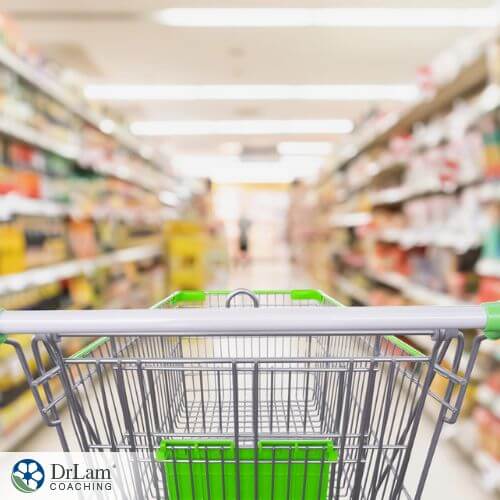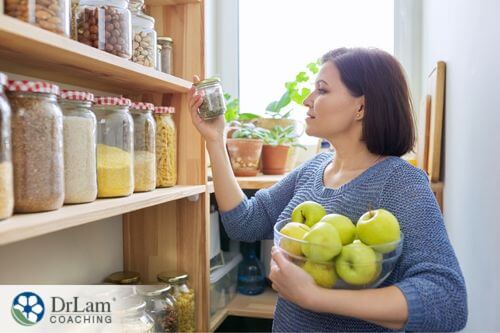 How many times have you gone grocery shopping only to wander the aisles without any real idea of what to get? And how many times have you arrived home with a random bunch of ingredients or worse, unhealthy snacks and desserts? Grocery shopping isn’t easy these days with all the different choices and options. And no one really teaches you which foods to add to your cart and which to leave on the shelf. That’s the goal of this article, which will teach you how to grocery shop so that you can support your health goals.
How many times have you gone grocery shopping only to wander the aisles without any real idea of what to get? And how many times have you arrived home with a random bunch of ingredients or worse, unhealthy snacks and desserts? Grocery shopping isn’t easy these days with all the different choices and options. And no one really teaches you which foods to add to your cart and which to leave on the shelf. That’s the goal of this article, which will teach you how to grocery shop so that you can support your health goals.
Your diet is an absolutely essential element of your health, perhaps even one of the most essential. It’s a simple fact that you can’t be healthy if your diet is unhealthy. Here are some of the issues you may experience if you don’t eat a healthy, balanced diet:
A healthy, balanced diet is also absolutely essential for healing. When you’ve been sick or unwell, a healthy diet will help give your body all the nutrition that it needs to heal itself. And if you don’t give your body what it needs to heal, then your natural healing processes will be slower than usual or worse, incomplete.
Many of these diet choices start at the grocery store. So that's why it's so important to learn how to grocery shop for better health.
Learning how to grocery shop for better health will take time and practice. It isn’t difficult, it’s just a matter of getting organized and breaking the bad habits of reaching for easy, convenience foods. Here’s how to get started:
Preparing to shop is an essential part of learning how to shop. There are several strategies you can use before you go shopping to ensure that you get what you need. Here’s what to do before you head to the store:
Check to see what you have and what you can make with it.
Decide what you want to eat during the week, so you aren’t buying random ingredients and hoping that they go together. If you’re new to planning your meals ahead of time, then start planning one or two meals at first and gradually add more as you get used to it.
Think of easy meals for breakfast and lunch, for example oatmeal and sandwiches, and then just look up the recipe for one or two dinner meals, and make sure you have all the ingredients.
Having a shopping list will help you make better choices in the shop, will keep you on task, and help ensure that you don’t forget any essentials. Stick one to your fridge all week, so you can add things as you think of them. You can also use an app to keep one ready on your phone.
 If you don’t like to shop or aren’t very good at it, then you need to make sure that your pantry, fridge, and freezer are stocked with long-lasting foods that can be put together to make a meal. This will ensure that when you get home tired and hungry, you’ll have something quick and easy to put together into a meal.
If you don’t like to shop or aren’t very good at it, then you need to make sure that your pantry, fridge, and freezer are stocked with long-lasting foods that can be put together to make a meal. This will ensure that when you get home tired and hungry, you’ll have something quick and easy to put together into a meal.
You’ll need to buy perishables more often with this approach, but it’s an easy way to always have healthy food on hand. Here are some longer-lasting foods to focus on:
Knowing how to grocery shop also means knowing how to avoid the traps of bad food choices and focus on the healthiest foods to buy. Here’s how to do that:
If you’re hungry when you shop, you’re more likely to fall for sales or for displays of your favorite, fatty foods. So make sure you have a healthy meal or snack before you head into the shop.
When you’re shopping, make sure you stick to your shopping list as much as possible. This will encourage you to buy only the nutrient dense foods that you planned to buy and help you avoid impulse buys. You might plan to allow yourself one impulse buy as a compromise and to avoid getting more than you need.
You should always check labels. Packaged foods aren’t necessarily unhealthy, but you’ll need to read the label to know that. Here’s what to look for:
And something is not necessarily healthy just because it’s labeled organic or gluten-free; it still may contain too much sugar or lots of unhealthy ingredients.
Most shops tend to offer displays and sales of unhealthy foods, such as sodas. These are usually found at the ends of aisles or near the counters, so be ready for the temptation. If you want to buy discounted food, stick to foods that are already on your list or that are very close to foods on your list (a different brand of healthy bread or almond milk, for example).
The outer edges of grocery stores usually contain the healthiest foods like vegetables, fruits, proteins, and frozen foods. When you’re learning how to shop, try to stay mostly in these aisles with quick trips to the middle aisles for grains, nuts, and other healthy essentials. If you can, avoid the soda, chips, and candy aisles altogether.
 Eating a healthy diet, one that includes all the vitamins and minerals that the body needs, is an essential step in recovering from many health conditions. And to do this, you will need to know how to grocery shop.
Eating a healthy diet, one that includes all the vitamins and minerals that the body needs, is an essential step in recovering from many health conditions. And to do this, you will need to know how to grocery shop.
One common condition, Adrenal Fatigue Syndrome (AFS), is caused by chronic or severe stress. Eating healthy is one of the best ways to prepare your body to deal with stress.
The first reason why a healthy diet is essential for AFS healing is because a it will naturally boost healing. It helps ensure that the body has everything it needs to heal damage and to function at its best.
The second reason why diet is essential to AFS recovery is that a poor diet is often a key source of stress in people with AFS. AFS occurs when chronic, ongoing stress builds up over time, preventing the body from resting and healing. When you’re stressed, the NeuroEndoMetabolic (NEM) stress response activates. This prompts the release of cortisol from the adrenal glands, which makes changes throughout the body’s organ systems that help you survive the cause of the stress.
Once the cause of the stress is gone, the NEM stress response shuts down, cortisol levels go back to normal, and the body’s circuits, composed of related organ systems, go into rest and repair mode. But when stress is chronic and ongoing, the NEM stress response remains active. This causes fatigue to the adrenal glands, which are under pressure to release more and more cortisol. It also causes imbalances in the body’s circuits, which are forced to remain in their stressed state.
A poor diet, one that’s filled with processed, fatty, sugary, or nutrient deficient food, is a common cause of the stress that brings on AFS in the modern world. A poor diet may also cause other health problems that bring on additional stress such as deficiencies and health concerns like diabetes or high blood pressure.
If you’re going to manage these health issues, then you need to learn to use your diet to support your health and your body. This means giving your body everything it needs to heal and function properly and remove foods that cause inflammation and stress.
Learning how to grocery shop to support a healthier diet can be a key part of your healing journey.
There are lots of different components to good health, but the food you eat is one of the most important. Unfortunately, getting this right isn’t easy because of the overload of choices at the store.
That’s why you need to learn how to grocery shop, so that you know that your diet is supporting the healthy lifestyle that you want build. Here’s how to start building better shopping habits:
For more help with building a healthy diet and reaching your health goals, talk to our team at +1 (626) 571-1234 or click here.
There are lots of choices in the grocery shop these days, and a lot of different foods are labeled as healthy when they really aren’t. That’s why you need to learn how to grocery shop, so that you can buy foods that support your health goals.
